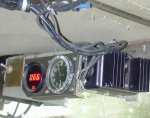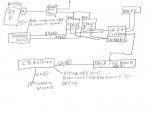kicker9898
Member
- 39
- 0
- 6
- Location
- oklahoma
Sorry to come to the community with another question about wiring.
One of my pyle converters fried tonight after getting everything hooked up what I thought was correctly.
I have a negative ground feed coming from the 24V neg battery post to a bussbar, both converters 24V NEG wires are hooked into this grounding bar.
I have 2 fuse panels hooked to the 12V side of the converters, and these are grounded back to the 12V Neg side of the converters.
I have another fuse panel for accessories that I ran up front under the dash, my CB and stereo were hooked to it. I was having problems with them and finally thought to check the voltage with a multimeter, it was getting 24V. These radios were grounded to the chassis, not the negative on the main fuse panel.
I was trying to figure out what would cause that and realized that my negative battery connection to the buss bar was not hooked up. I hooked it up and fritz! there went one of my converters.
So, should I have grounded the 24V to the chassis instead of the negative battery terminal? What was causing 24V to go to what should be 12V fuseblock? Should the 24V feed not be grounded or should the converters 12V side not be grounded?
Jason
One of my pyle converters fried tonight after getting everything hooked up what I thought was correctly.
I have a negative ground feed coming from the 24V neg battery post to a bussbar, both converters 24V NEG wires are hooked into this grounding bar.
I have 2 fuse panels hooked to the 12V side of the converters, and these are grounded back to the 12V Neg side of the converters.
I have another fuse panel for accessories that I ran up front under the dash, my CB and stereo were hooked to it. I was having problems with them and finally thought to check the voltage with a multimeter, it was getting 24V. These radios were grounded to the chassis, not the negative on the main fuse panel.
I was trying to figure out what would cause that and realized that my negative battery connection to the buss bar was not hooked up. I hooked it up and fritz! there went one of my converters.
So, should I have grounded the 24V to the chassis instead of the negative battery terminal? What was causing 24V to go to what should be 12V fuseblock? Should the 24V feed not be grounded or should the converters 12V side not be grounded?
Jason





